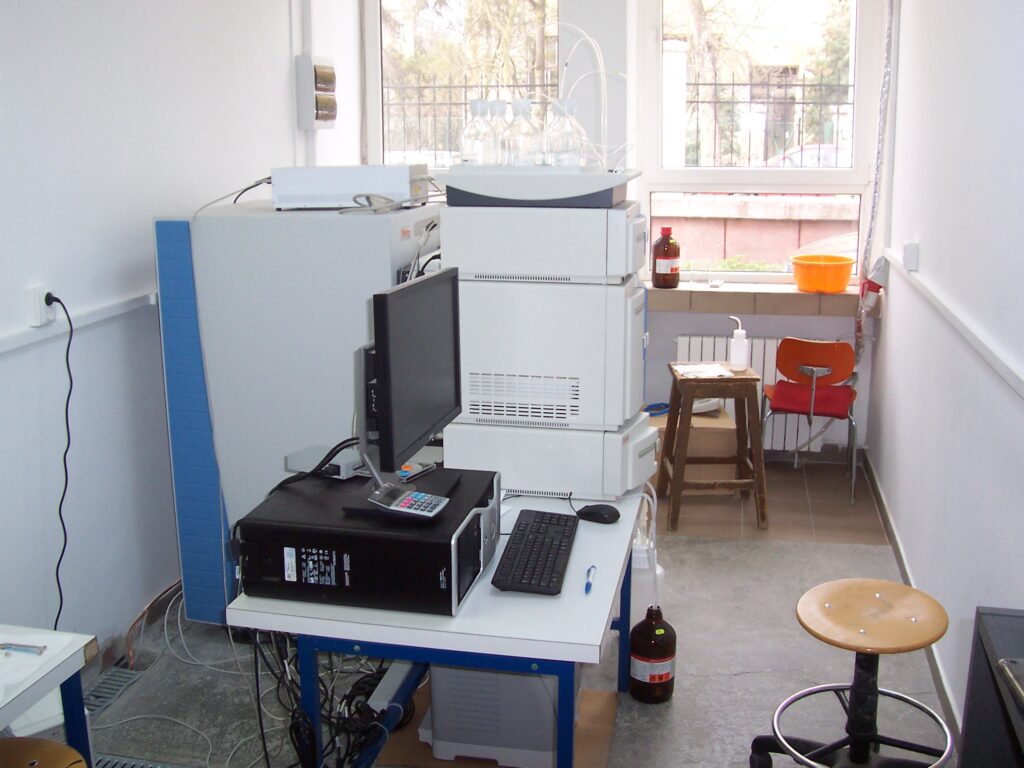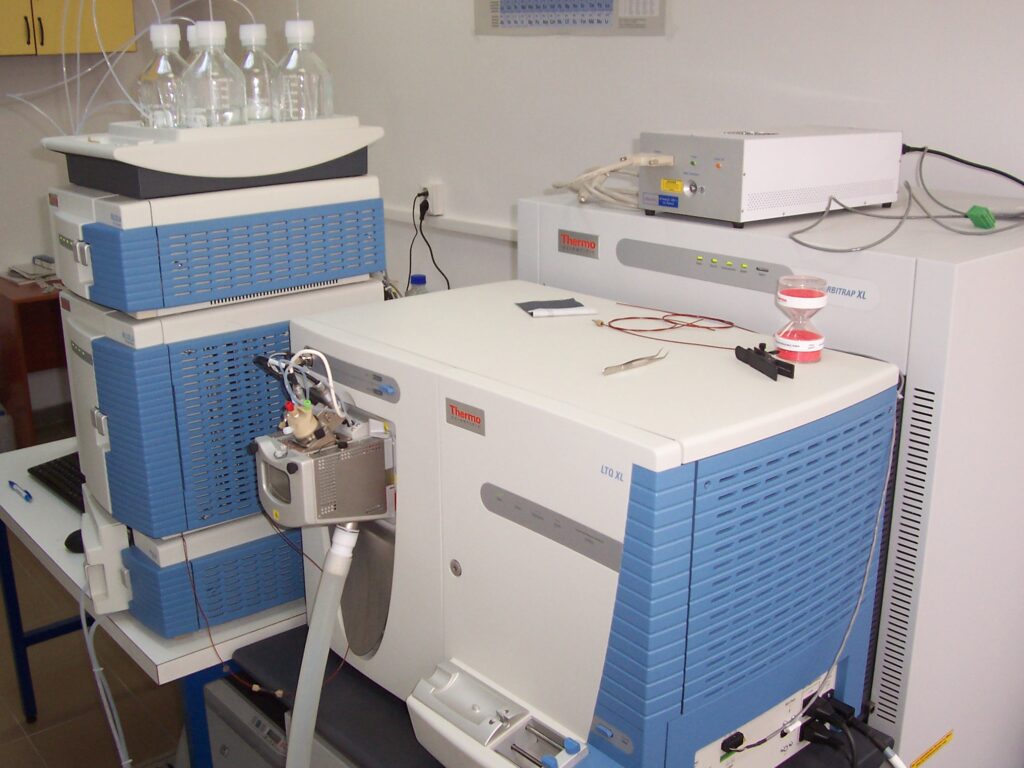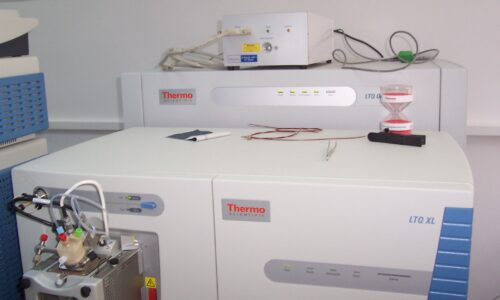Supramolecular Organic and Organometallic Chemistry Centre (SOOMCC) leaded by Prof. Cristian Silvestru and Prof. Ion Grosu brings together a group of about 40 scientists including permanent staff, post-doctorates and PhD students from the Faculty of Chemistry and Chemical Engineering, Babeș-Bolyai University (BBU), Cluj-Napoca. The Center develop research in the fields of organic and organometallic synthesis, supramolecular chemistry, stereochemistry, development of organic and organometallic materials with magnetic, optical and electronical properties as well as their applications as heterogeneous catalysts or supports for metal catalysts, CO2 capture and storage, organic solar cells and others. SOOMCC was recognized by BBU as a Center of Excellence since 2010. One of the major infrastructures managed within the SOOMCC is the High-Resolution Mass Spectrometer LTQ Orbitrap XL, ThermoScientific.



High-resolution mass spectrometer LTQ Orbitrap XL installed at the Faculty of Chemistry and Chemical Engineering, BBU is a hybrid system composed of a linear ion trap (allowing the measurement of low-resolution mass spectra) and a state-of-the-art orbital ion trap (which allows measurement of high-resolution mass spectra). The main accessories of the instrument are: five ionization sources (see below), an Accela liquid chromatograph and a Parker Domnick Hunter LCMS15-1 nitrogen generator.
The mass spectrometer LTQ Orbitrap XL allows: (a) determination of the exact mass of the analyzed compounds with an accuracy of less than 3 ppm, value below the accepted limit (5 ppm) for determining the identity of a compound; (b) recording high- or low-resolution mass spectra using five different ionization techniques i.e. Electrospray (ESI), Atmospheric Pressure Chemical Ionization (APCI), Atmospheric Pressure Photoionization (APPI), Matrix-Assisted Laser Desorption/Ionization (MALDI), both in positive and negative ionization modes; (c) determination of the isotopic composition of the analyzed samples; (d) building-up the fragmentation scheme of the analyzed compounds through MSn experiments; (e) HPLC-MS and HPLC-MS/MS experiments; (f) study of supramolecular complexes and architectures; (f) qualitative and quantitative determination the composition of complex mixtures; (g) separation, identification and study of peptide and proteins; (h) determination of the structure and molecular mass distribution of polymers etc.
Access policy
Opening hours: Monday to Friday, 9h00-17h00. No particular access conditions are required. Trained staff within the laboratory perform all experiments for the beneficiaries with or without data interpretation. Access to the infrastructure is restricted during the teaching activities and the periods of technical revision of the instrument. Students, PhD students and teaching staff from BBU have access to the experimental facility within training programs and research projects.
Third-party access to the infrastructure is based on research contracts, co-joint publishing, exchange of experience and transfer of technology and skills programs.
Contact
Dr. Niculina Daniela Hădade,
Faculty of Chemistry and Chemical Engeneering, 11, Arany Janos street, Cluj Napoca, Romania,
e-mail: niculina.hadade@ubbcluj.ro
Research and publications – more than 250 publications in the last 10 years. A list of 10 selected articles published in the last 2 years
- Two are better than one – Synthesis of novel blue and green emissive hydroxy-oxadiazoles C. C. Anghel, C. Bădescu, A. G. Mirea, A. Păun, N. D. Hădade, A. M. Mădălan, M. Matache, C. C. Popescu Dyes and Pigments, 2022, 109927.
- Structure-properties of small donor-acceptor molecules for homojunction single-material organic solar cells N. Terenti, G. -I. Giurgi, C. Anghel, A. Bogdan, A. Pop, I. Stroia, A. Terec, L. Szolga, I. Grosu, J. Roncali, J. Mater. Chem. C 2022, 10, 5716-5726.
- Effect of the mode of fixation of the thienyl rings on the electronic properties of electron acceptors based on indacenodithiophene (IDT). N. Terenti, A. P. Crisan, S. Jungsuttiwong, N. D. Hădade, A. Pop, I. Grosu, J. Roncali, Dyes Pigm. 2021, 109116.
- An attempt to synthesize a terthienyl-based analog of indacenedithiophene (IDT): unexpected synthesis of a naphtho[2,3-b]thiophene derivative.C. C. Anghel, I. Stroia, A. Pop, A. Bende, I. Grosu, N. D. Hădade, J. Roncali, RSC Adv. 2021, 11, 9894–9900.
- Structure-properties relationships in triarylamine-based push-pull systems-C60 dyads as active material for single-material organic solar cells A. Bogdan, L. Szolga, G,-I. Giurgi, A. P. Crişan, D. Bogdan, S. Hadsade, S. Jungsuttiwong, R. Po, I. Grosu, J. Roncali Dyes Pigm., 2021, 184, 108845.
- Synthesis and characterization of [4-{(CH2O)2CH}C6H4]2Hg, [4-(O=CH)C6H4]2Hg and [(E)-4-(RN=CH)C6H4]2Hg (R = 2′-py, 4′-py, 2′-pyCH2, 4′-pyCH2), L. Kiss, A. Pop, S. Shova, C. I. Raț, C. Silvestru, Appl. Organomet. Chem. 2021, 35, e6339.
- Synthesis, structural characterization and in vitro antiproliferative effects of novel organotin(iv) compounds with nicotinate and isonicotinate moieties on carcinoma cellsS.-M. Vieriu, A.-A. Someşan, C. Silvestru, E. Licarete, M. Banciu, R. A. Varga, New J. Chem. 2021, 45, 1020–1028.
- Reactivity of a carbonyl moiety in organotin(iv) compounds: novel Pd(ii) and Cu(ii) complexes supported by organotin(iv) ligandsA.-A. Someşan, C. Silvestru, R. A. Varga, New J. Chem. 2021, 45, 3817–3827.
- Bulky Polyfluorinated Terphenyldiphenylboranes: Water Tolerant Lewis Acids C. Stoian, M. Olaru, T. A. Cucuiet, K. T. Kegyes, A. Sava, A. Y. Timoshkin, C. I. Rat, J. Beckmann, Chem.-Eur. J. 2021, 27, 4327–4331.
- Shifting emission of oxadiazoles via inter- or intramolecular hydrogen bonding C. C. Anghel, A. G. Mirea, C. C. Popescu, A. M. Mădălan, A. Hanganu, A. Bende, N. D. Hădade, M. Matache, M. Andruh, Dyes and Pigments, 2023, 210, 111023.


